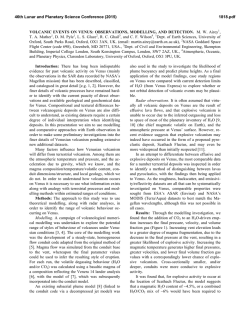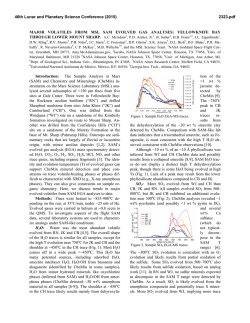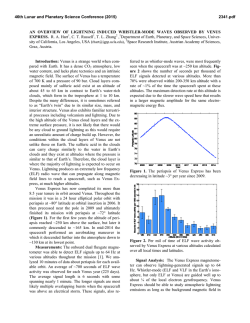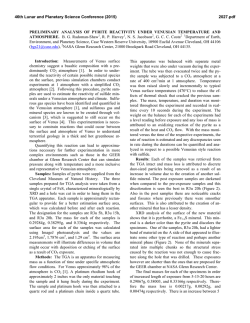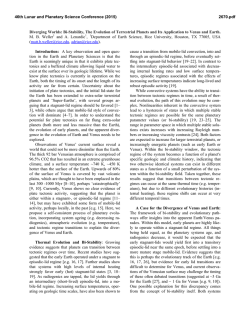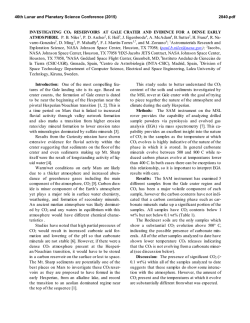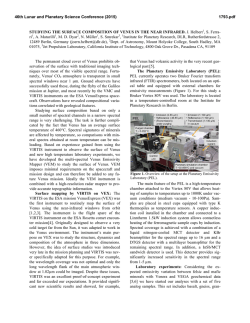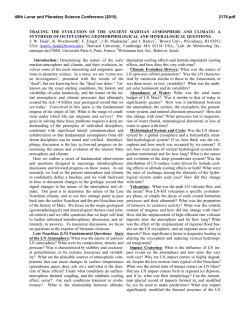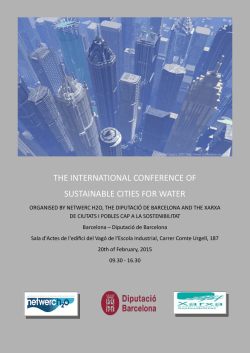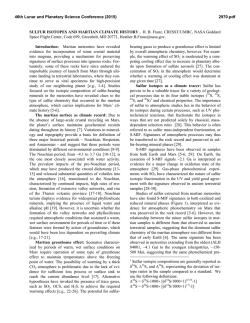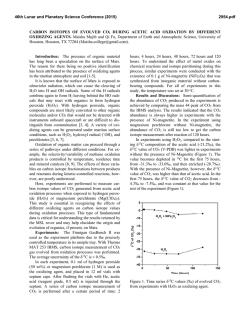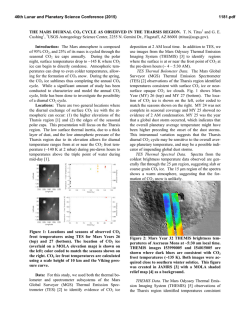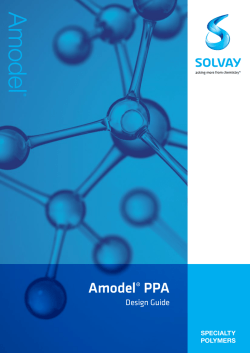
Thermodynamic Features Governing the Atmospheric Composition
46th Lunar and Planetary Science Conference (2015) 1067.pdf Thermodynamic Features Governing the Atmospheric Composition on Venus. A. Pilchin1*, 1 Universal Geoscience & Environmental Consulting, 205 Hilda Ave., #1402, North York, Ontario, Canada, M2M 4B1. (*[email protected]). Introduction: Previous researches conducted on Venus show that: the atmospheric pressure near its surface is now on average ~9.56 MPa [1]; the average surface temperature is about 740 K [1]; there is a thick cloud system (a global cloud layer at altitudes of ~45 to ~70 km) [2]; there is virtually no data on the chemical composition and thermal structure of the Venusian lower atmosphere below an altitude of ~22 km [1]; it reflects about 75% (spherical albedo) or ~0.84 (geometric albedo) of incidental solar radiation [3]; the shortage of direct measurements leaves no alternative but to use methods of infrared spectroscopy to analyze the atmospheric composition; the atmosphere is predominantly composed of CO2 (96.5%) and N2 (3.5%), with smaller amounts of SO2, H2O, H2SO4, CO, OCS, HCl, HF and traces of certain other compounds [1, 2]; lastly, thermodynamic conditions at their highest (Maxwell Montes) and lowest (deep depressions; -2 km) altitudes are about 650 K, 4.5 MPa and 755 K, 11.0 MPa, respectively [4]. Methods: Thermodynamic methods used to estimate and analyze the composition of the early Earth atmosphere [5, 6, 7] were applied to the atmosphere of Venus. The methods involve determining the densities of the primary atmospheric compounds under different P-T-conditions, comparing them, and determination the different layers and their positions within the atmosphere. For atmospheric composition, the main components of volcanic gases and fumaroles (H2O, CO2 and SO2) were accepted. Experimental data of [8] was used to calculate the densities of H2O and CO2; and experimental data of [9] was used to calculate the density of SO2, with calculations employing thermodynamic and fluid laws used for temperatures above 523 K. Thermodynamic conditions in the atmosphere of Venus and main features of its composition: Thermodynamic analysis of conditions of the early Earth atmosphere shows [5, 6, 7] that: the content of carbon oxides was governed by the Boudouard reaction (2CO = CO2 + C), the content of CO and CO2 is equimolar respectively at 947 K and at 673 K with content of CO less than 1%; the content of sulfur oxides was constrained by the disproportionation reaction (2SO2 = SO3 + S), with SO3 content of ~55% at 873 K, ~90% SO3 at 773 K, and up to 100% at 673 K; sulfuric acid is the main compound containing sulfur oxides at temperatures below about 700-610 K depending on pressure. Elemental sulfur has a boiling point as high as 717.75 K [10]. A comparison of this data with the thermodynamic conditions within the atmosphere of Venus shows that near the surface: the main carbon oxide is CO2; the main sulfur compounds should be SO3, H2SO4 and S0; and that water could not be in its liquid state. Analysis of thermodynamic characteristics of the main components of the atmosphere of Venus shows that: under average atmospheric pressure and temperature near the surface such compounds as CO2, CO, SO2, SO3, COS, HCl, HF, H2S, Cl2 and F2 are in supercritical condition; H2O is in critical condition by temperature; sulfuric acid is in critical condition by pressure; while elemental sulfur (S, Sn; n is from 2 to 8) is not in critical condition [5, 6, 7]. Comparing the critical pressure (PC) and critical temperature (TC) of most typical compounds with the actual distribution of pressure and temperature with altitude within the atmosphere of Venus shows that: CO2 is in critical condition by temperature at altitudes of ~5-51 km and in its gas state at altitudes of ~60-70 km; both SO2 and SO3 are in critical condition by temperature at altitudes of ~530 km and in their gaseous states at the temperatures at ~40-70 km; H2SO4 is in critical condition by pressure at altitudes of up to ~10 km, and in its liquid state at ~10-60 km, as well as for concentrations of over 30% at ~70 km; H2O is in critical condition by temperature at altitudes of up to ~10 km, vaporous until ~39 km, liquid until ~58 km and ice at ~58-70 km; elemental sulfur (Sn) should be in its vaporous state below an altitude of ~2-3 km, and liquid until ~44 km. Results of calculating the densities of H2O, CO2 and SO2 at different temperatures and pressures show that: the densities of these compounds are respectively about 32, 70 and 159 kg/m3 for a pressure of 10 MPa, and 16.5, 38.0 kg/m3 for 5 MPa (the density of SO2 was not calculated for P=5 MPa, but is certainly greater than that of the other two compounds); under pressure of ~10 MPa H2O is denser than CO2 at temperatures below 550 K, and denser than SO2 only within the range of about 473-573 K; under pressure of ~5 MPa H2O is denser than CO2 at temperatures below 600 K, and it is denser than SO2 only within the range of about 450-600 K; while SO2 is denser than CO2 throughout the entire range of temperatures (273-823 K) and pressures (5 and 10 MPa) used for calculating their densities. The last fact is extremely important, because the primary sulfur compounds stable under the P-Tconditions at surface of Venus are SO3, H2SO4 (at altitude 5 km and above) and S0, which have densities increasing in the order (from left to right) SO2 → SO3 → H2SO4 → Sn [10]. At the same time, SO2 is unstable at 46th Lunar and Planetary Science Conference (2015) altitudes above ~12 km. This means that among the mentioned sulfur compounds, only SO3 and S0 could be present on the surface of Venus. If these compounds were not yet re-distributed into the crust, as happened with the early Earth atmosphere [5, 6, 7], they would be present only at and near the surface of Venus. The results also show that under the temperature conditions within the atmosphere of Venus, the CO2 near the surface and at altitudes with a pressure of ~5 MPa (up to an altitude of about 30 km) is denser than H2O and would take a position between the sulfur-layer and the water-layer. Within the interval of altitudes between ~30 km and ~39 km, the densities of CO2 and H2O are somewhat close and can exist as a mixture. However, at altitudes from ~38-39 km to ~58 km water should be in its liquid state, and from ~58 km to 70 km and up water (as ice) is clearly denser than CO2. Composition of the atmosphere on Venus: During planetary accretion on Venus, the three main layers of the atmosphere (sulfur-, carbon- and water-layer) were formed similarly to that of the early Earth atmosphere [5, 6, 7]. The sulfur-layer (lowest in the atmosphere) by now was either completely or mostly redistributed into solid rocks. The water-layer (upper) was open for Sun’s UV-radiation ~4.6 billion years and lost most of its water through photodissociation and escape of hydrogen. The carbon-layer is still mostly unchanged, because of absence of water bodies on the surface required for the re-distribution of CO2, just as it was on Earth [5, 6, 7]. The main features governing the composition of the atmosphere on Venus are: water has no access to the surface and is likely not present below an altitude of ~30 km (density within the atmosphere between 9 and 10 km is ~39 kg/m3 [11] and the density of water vapor is ~17 kg/m3); H2SO4 can only be formed above ~30-38 km (due to necessity of H2O); volatile sulfur compounds probably concentrate near the surface (estimated density near the surface is 64.79 kg/m3 [11] and calculated density of SO2 is ~150 kg/m3); formed H2SO4 should move downward (by density) and decompose at a height of 5-10 km; near the surface sulfur compounds can be present only as supercritical fluids of SO2 and SO3, and Sn vapor; CO is not stable within the atmosphere. Comparing these conditions with the atmospheric abundances of the main components derived by experimental measurements and estimated with infrared spectroscopy shows that: concentrations of SO2 (main sulfur compound in volcanic fluids) of about 150-200 ppm at altitudes of 22-42 km [4] is explained by their ejection during volcanic activity; H2O content of ~20 ppmv near the surface [1] and 20-200 ppm below 20 km [13] is explained by the release of water during the decomposition of H2SO4; the boundary line between the vapor and liquid state of water is ~39 km, but liquid water 1067.pdf droplets can fall below this line until they vaporize (they can fall for up to 12 km [13]) and vapor can rise above 39 km until it liquefies (raining out–vaporization is likely between ~30 and 50 km); a similar raining out–vaporization effect could take place between ~5 and ~20 km for H2SO4; it is possible that the presence of H2SO4 was the reason for the destruction of some devices on the Venera 11–14 and Vega 1–2 landers at altitudes below 12 km; and equipment failure on all four probes from Pioneer Venus at altitudes 12-14 km [13]; the high content of H2O measured, at 2000 ppm by humidity sensors of Venera 13-14 [13], up to 0.519% by Pioneer Venus [14], 1000-10000 ppm by Venera 4-6 [13], ~1000 ppm by Vega 1-2 [15] can be explained by the presence of liquid water droplets. Infrared spectroscopy and composition of the atmosphere: The content of different components within the atmosphere was determined by infrared radiation absorbing bands (for CO2 they are centered at 2.7, 4.3 and 15 μm). Research shows that bands centered at 2.7 μm have: water vapor [17], water molecule [17], CO2 in solid H2O and H2O/CO2 as ice [18], H2SO4 at increased temperatures [19], some sulfates [20]; 2.74 μm have liquid water [21] and an OH band [18]. These facts suggest that the share of H2O and H2SO4 may be higher and the share of CO2 lower than presently accepted for the atmosphere. References: [1] Fegley B. (2004) Treatise on Geochemistry, Vol. 1487-507. [2] Fegley B. (2009) Encyclopedia of Paleoclimatology and Ancient Environments, 5-83. [3] Moroz V. (1983) Venus, Vol. 1, 2735. [4] Basilevsky A. T. & Head J. W. (2003). Reports on progress in physics, 66, 1699–1734. [5] Pilchin A. (2011) Magnetite: Structure, Properties and Applications. Ch. 1, 1-99. [6] Pilchin A. & Eppelbaum L.V. (2012). Encyclopedia of Earth Science Research, 1-93. [7] Eppelbaum L. et al. (2014) Applied Geothermics. [8] Clark S. P. (1966). Handbook of physical constants. [9] Ihmels E. C. et al. (2003) Fluid Phase Equilibria, 207, 111-130. [10] Lide D. R. (2004). Handbook of Chemistry and physics. [11] Marov M. Ya. & Grinspoon D. H. (1998) The Planet Venus. [12] Esposito L. W. et al. (1997) Venus II, Vol. 1, pp. 415-458. [13] Kondrat’ev K. Ya. et al. (1987) Planet Venus. (in Russian) [14] Oyama V. I. et al. (1979) Science, 203, 802805. [15] Surkov Yu. A. et al. (1982) Let.to Astronom. Journ., 8(7), 411-413. [15] Gomarasca M. A. (2009) Basics of Geomatics. [17] Menzel W. P. (2001). WMO Satelite reports, SAT-28. [18] Bernstein M. P. et al. (2005) Icarus, 179, 527-534. [19]. Biermann U. M. et al. (2000) J. Phys. Chem. A, 104, 783-793. [20] Cloutis E. A. et al. (2006) Icarus, 184, 121–157. [21] Venyaminov S. Yu. & Prendergast , F. G. (1997) Analytic. Biochem., 248, 234–245.
© Copyright 2025
